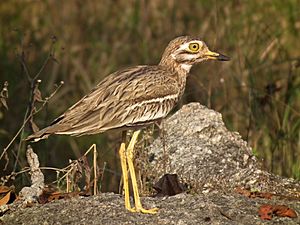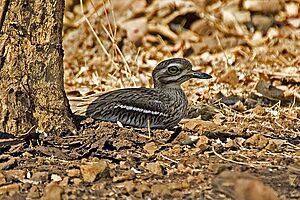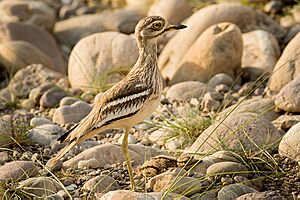Indian stone-curlew facts for kids
Quick facts for kids Indian stone-curlew |
|
|---|---|
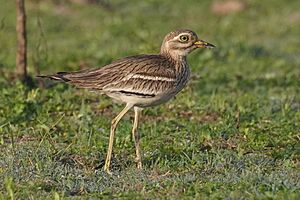 |
|
| Conservation status | |
| Scientific classification | |
| Genus: |
Burhinus
|
| Species: |
indicus
|
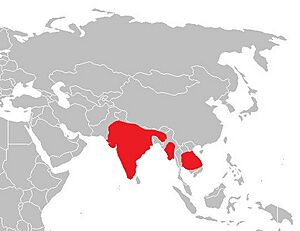 |
|
| range | |
| Synonyms | |
|
|
The Indian stone-curlew or Indian thick-knee (Burhinus indicus) is a type of bird. It belongs to a bird family called Burhinidae. This bird lives in the flat areas of South and South-eastern Asia.
These birds have big eyes and are mostly brown with stripes and light spots. This coloring helps them blend in with the ground and rocks. They are usually active when it's dark. Their calls sound a bit like other birds called true curlews, which is how they got their name.
Contents
Understanding the Indian Stone-Curlew
Scientists first officially described the Indian stone-curlew in 1866. It was named Oedicnemus indicus at that time. The word "indicus" means "Indian" in Latin.
This bird is now placed in a group called Burhinus. For a while, the Indian stone-curlew was thought to be a type of Eurasian stone-curlew. However, the Indian birds look different and do not migrate. Because of this, experts decided in 2005 that it is its own unique species.
What Does the Indian Stone-Curlew Look Like?
This bird is about 41 centimeters (16 inches) long. It is a sturdy, brown ground bird with large eyes. It has dark stripes on its sandy-brown body.
Its head is large with a dark stripe below the eye. There is also a thin, creamy stripe above the eye. The bird's legs are strong, and its knees look thick. This is why they are sometimes called "thick-knees." They also have big yellow eyes.
Male and female Indian stone-curlews look alike. Young birds are paler than adults. They have more buff and stripes on their undersides. When they fly, you can see two bright white patches on their darker wing feathers. When they are resting, a wide light band is visible on their wings.
Where Do Indian Stone-Curlews Live?
These birds live in dry forests with deciduous trees. They also like thorny forests, scrubby riverbeds, and even gardens. You can find them in countries like Bangladesh, Bhutan, Cambodia, India, Laos, Myanmar, Nepal, Pakistan, Sri Lanka, Thailand, and Viet Nam. They prefer thin dry forests, scrubland, rocky hillsides, and empty fields.
How Do Indian Stone-Curlews Behave?
Indian stone-curlews are most active during dawn and dusk. They mostly call out at night. Their call sounds like a series of sharp whistles. It often goes pick-pick-pick-pick and sometimes ends with pick-wick, pick-wick.
They usually live in small groups. During the day, they often stand very still. They like to rest under the shade of a bush.
Reproduction and Life Cycle
The main time for breeding is in March and April. A female bird usually lays 2 to 3 eggs. The eggs are stone-colored and are laid in a shallow dip on the bare ground. Sometimes, they lay them at the bottom of a bush.
The female bird mostly sits on the eggs to keep them warm. The male bird stands nearby to guard the nest. The baby chicks are covered in soft downy feathers. They are also camouflaged to blend in with their surroundings. They can follow their parents soon after hatching. When young chicks get scared, they freeze and crouch down. Their camouflage makes them very hard to see.
What Do Indian Stone-Curlews Eat?
The Indian stone-curlew mainly eats insects, worms, and small reptiles. Sometimes, they also eat seeds.
Images for kids



